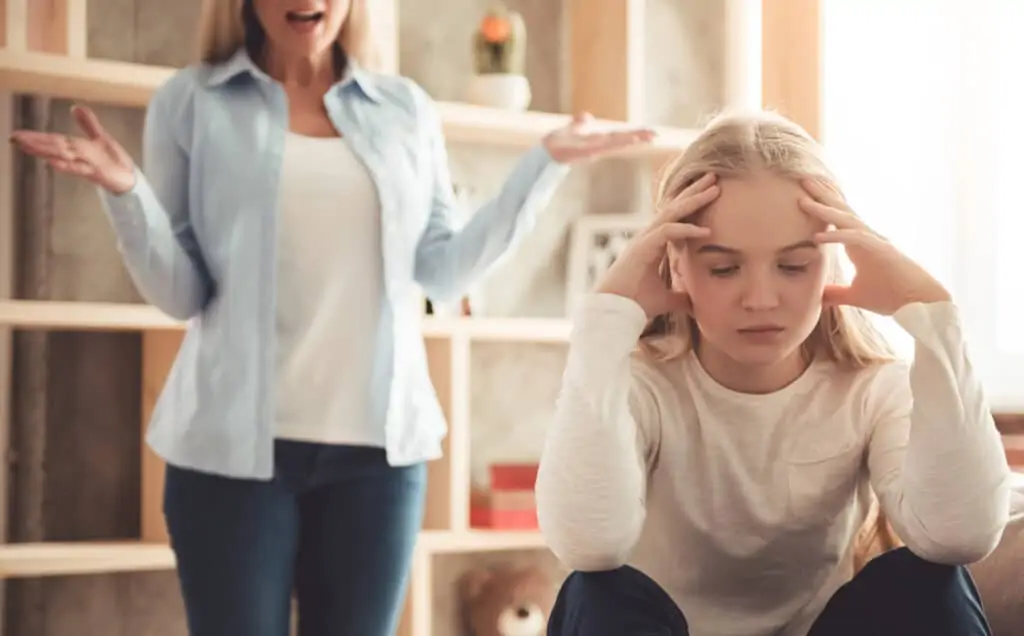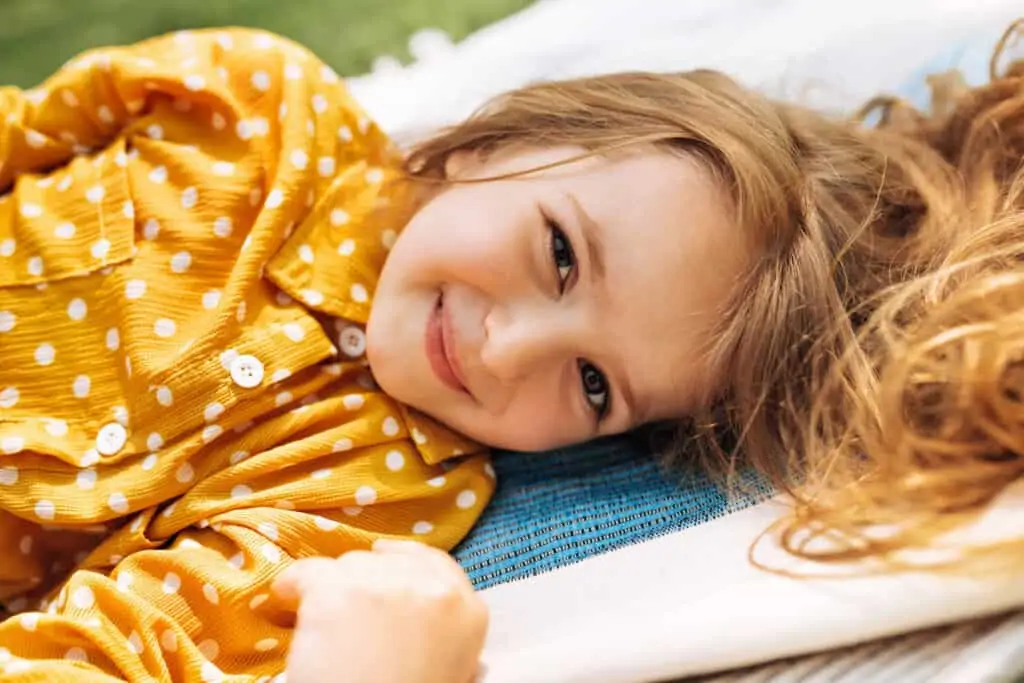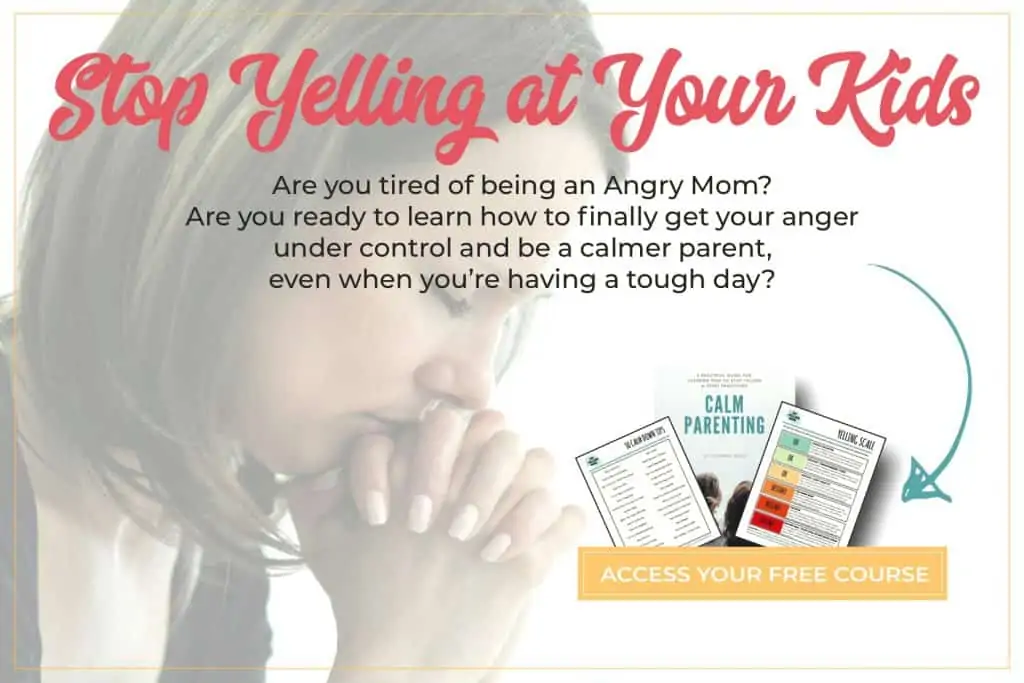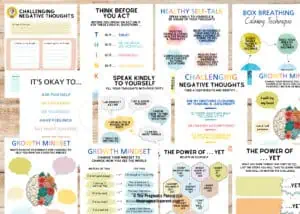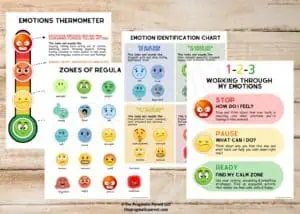Unsure how to deal with back talk? How to appropriately respond instead of react & calm disrespectful behavior, letting natural consequences teach the lesson whenever possible. One of my favorite tools are in the Emotion identification tools which helps kids identify, name, communicate their feelings and what’s going on under the surface instead of covering them up in other ways.
6 Steps to Handle Backtalk & Peacefully Discipline Children
It seems backtalk is a common problem with parents these last few weeks.
How do I know this?
Because my email has been flooded with SOS messages from parents, begging for help to stop the eye rolling and back talk.
I know what you’re feeling.
My 8-year-olds recently started testing these waters, and my patience had become razor thin dealing with this new development.
But, don’t worry.
I have a solution for you, and I know it will help transform your family like it’s done mine.
In the past, I berated my children with lectures and said rhetorical things like, “You can’t speak to me like that,”or “Why in the world do you think you can talk to your Dad and I that way?”
Of course, none of these sorts of questions gave me any insight into what was going on. And they never helped the situation.
But, I’ve slowly learned to do better.
It’s taken some practice, but now I know to wait until after the heat of the moment has passed before I do any sort of discipline.
Studies show that when children are in a reactive state they are not receptive to what a parent says. This means, if they’re angry, irritated, scared, upset or even excited, aren’t receptive to a parent speaking to the.
So how do you get them to be in a receptive state?
The first step to stopping backtalk is understanding why it is happening in the first place.
Reading parenting book after parenting book, one of the common themes is all behavior is communication.
When I started using my new technique for handling talking back, I anticipated it’d be a long, drawn-out process. Instead, my kids began responding in only a few minutes and the result has been transformativefor my family.
My son no longer feels like he needs to draw me into a fight to prove his point.
His actual words were, “I just wanted to win (the argument)” so you understands I have one strong-willed boy who has no problem giving me all he’s got when he’s in a mood.
Another thing?
My daughter doesn’t have to worry about me coming down hard on her and to my surprise, has begun telling me ev-er-y-thing about what’s bothering her, and has even become descriptive about her feelings.
This means, no more guessing games for my husband and I because trying to read minds often leads us to the wrong conclusions, amiright?
Before I would get frustrated enough to yellat my loved ones, which I know often had very little to do with what was going on in the given moment.
There were times when back talk would happen and I’d lose my cool because I was stressed, or worried about a work deadline, our finances, or getting my kids to the bus stop on time.
Here’s a Summary of Steps to Take When Backtalk Happens
(and then I’ll get into the finer details of how this process works next.)
- Have a private conversation.
- Direct the conversation.
- Listen without judgement, or reacting defensively or emotionally. Let them get it all off their chest.
- Paraphrase back to your child what you heard them say.
- Empathize
- Problem solve for next time together.
Handling Backtalk & Peaceful Problem Solving
-
Make It a Private Conversation
To connect with your child and get honest responses from them, it’s never a good idea to have this conversation in front of others and certainly not siblings.
Gently pull them into a quiet, private place where there’s no eavesdropping. This helps calm down the child and eliminate distractions for both of you.
Make sure screens, tv, and anything distracting in the private place are turned off.
-
Direct the Conversation
As the parent, you need to steer this conversation, because your child will be stuck in their middle brain where they aren’t open to rationale thinking, and need your guidance.
For younger kids, you can ask them questions like, “You seem sad right now, is that right?” or“You might be fussy because you’re hungry, is that right?”
For school-age children, start by saying something such as, “I noticed you seem angry we had to change our plans for the afternoon. What’s going on?”
Emotion picture cards can be helpful to get kids talking and also to name their emotions.
You may have to ask leading questions several times but the trick is to recognize their feelings and remain calm.
For older kids, reassuring them you’re there to listen without judgement and patiently waiting for their response may help.
If your child is stuck in their emotional center, just give it a few minutes so they can calm down and can get back to their higher brain where rationale thinking happens, before you start the conversation.
-
Listen without Judgement & React without Defensiveness or Emotion
Your only job once your child begins to talk, is to listen without any type of reservations or judgement. Give them space and time to get everything off their chest so they feel heard.
Don’t interject any words of wisdom or insight into the situation just yet. Simply, sit back and wait.
Don’t take a side if the situation has more than one child involved, emotionally react or try to get your point across (or win the conversation), just hear their side of the story.
Push your knee-jerk reactions aside even if it’s difficult when your child calls their brother or sister a jerk or places the blame on someone else.
Your only job is to listen and keep the dialogue going so your child can get it all off their chest.
-
Paraphrase back to your child what you heard them say
Show your child you’re listening by playing back what you heard them say like a tape-recording.
“What I hear you saying is…”
Do your best to cover the main points your child has made and ask them if this is right, and if you got it all.
-
Empathize with Your Child
Children want to be seen and heard, and when you empathize with themit makes them feel not only heard, but validates their feelings.
To you, their big emotions may seem unfounded or over-the-top but who are we to say children can’t feel this way.
Remember, children don’t begin developing the higher brain – the rationale part of themselves – until age 7 and it won’t fully mature until around the age of 24. This means, their emotional middle brain is almost all of what they experience and this is biologically how they’re wired, so there’s nothing they can even control.
Validate their feelings and empathize with them, to make they feel secure in themselves.
-
Problem Solve Together
If you simply draw up a story in your head, fill in the blanks incorrectly and spit out a form of punishment, this is where the power struggle will begin because it only compounds the problem – not gets to the bottom of it.
Once you’ve gone through steps 1 – 5, it’s time to move to problem solving (aka discipline.)
You’ve gotten to the bottom of the problem, heard their side of the story, and recognized their feelings, now it’s time to come up with a plan for next time.
“You’re allowed to feel angry and upset, but you can’t talk to me rudely. The next time you feel upset because we aren’t doing something you want to do, we need to have a private conversation about what’s going on and feelings. How about you ask if you can talk to me privately and we can come up with something we both agree on?”
Final Note on Handling Backtalk
When kids feel seen and then heard, they become more receptive to rationale thinking and problem solving.
This technique to stop backtalk, can be helpful for any emotional situation and helps take a step back from an explosive state.
When you ask questions, listen without judgement, recognize their feelings and empathize with them, it gives kids an instant dose of relief and strips away the overflowing emotions so they can respond calmly, and so can you.
Also, this form of open communication with your children stops their big emotions from building up under the surface, and exploding in bigger proportions later on. If you were to shut down backtalk without going through these steps, you’d have a volcano of emotions stuck under the surface, waiting to explode at a later and of much bigger proportions.
More Positive Parenting Resources
- How to Discipline a Child Without Using Punishment
- From Entitlement to Empathy: Cultivating Gratitude in Children
- Entitled Kids: What Entitlement Looks Like at Home & How to Fix It
- 12 Ways to Calm an Angry Child & The Brain Science Behind Outbursts
- Vital Tips for Parents Navigating the Transformative Tween Years
- Handling Toddler Tantrums: Big Emotions & Helping Your Toddler Feel Heard
- Why Empty Threats Don’t Work (And What To Do Instead)
- 14 Factors That Influence a Child’s Behavior or Trigger Their Misbehavior
